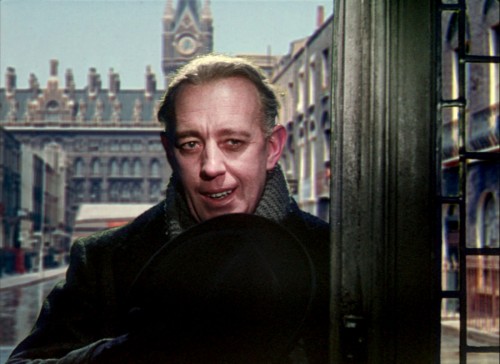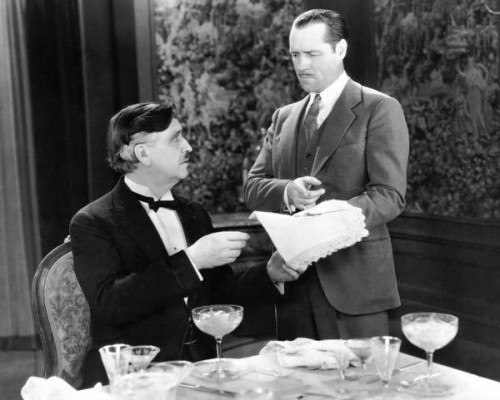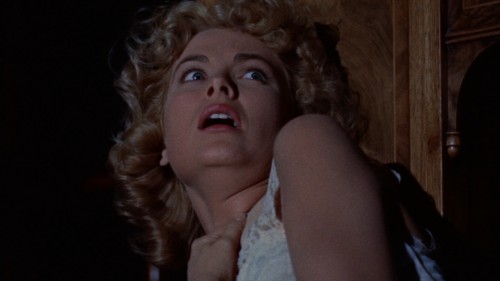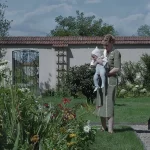TCM Fest, Part Two: Murder, My Sweet, by Scott Nye
Ah, murder! Where would fiction be without it? In an art form that requires extreme conflict, it’s no wonder we rush – creatively and commercially – so often to perhaps the worst thing you can do to another human. But given our need to not consider such actions too harshly, the popular culture finds ways to diminish, to lighten, to make fun from terror, and craft any number of stories in which we can get a little entertainment from that most dastardly of deeds. Three of the films I saw at TCM Fest exemplify this mode, sometimes classically, sometimes beautifully, and sometimes, a little messily.
I had not, until the festival, seen Alexander Mackendrick’s landmark 1955 black comedy, The Ladykillers, and, especially seeing as it was being shown in 35mm, was not especially keen to miss it. Saturday Night Live cast member Bill Hader introduced the film early on Saturday morning (one advantage to a festival geared towards an older crowd is they pack in screenings all day long), admitting after a little stumbling that he’d done absolutely no preparation before taking the stage, but treating us to a little of his Vinny Vedecci character, which, what can I do, kind of made up for it.
As for the film itself, I have to admit I didn’t find it quite as revelatory as all that, more entertaining than actually funny, though by the end, it certainly gains a sort of existential humor to it. It’s very easy to see the influence it had on the Coen Brothers, even without their remake (which I’ve yet to see). If one follows the local news of just about any town, one quickly discovers the mass stupidity that exists among criminals, and it’s really amazing that any crime is ever successfully perpetrated, all things considered, though this particular one has that great quality of coming this close to working, always a great device in fiction. When it finally descends into mass murder at the end, it’s far too late for any great success, as egos pile upon coincidence upon, yes, a little dash of idiocy to create the perfect downfall. I did enjoy the picture, but we were not seeing eye-to-eye, humor-wise.
Where The Ladykillers was somewhat incendiary for its time, there really couldn’t possibly be a more rote exercise than Frank Capra’s 1929 film, The Donovan Affair, which is the most basic template of a murder mystery as you’re likely the find. Adapted from an Owen Davis play by Howard Green and Dorothy Howell, it was Frank Capra’s first all-talking picture, though ironically, the sound element of the film has long been lost. In its place, Bruce Goldstein (director of New York’s fabulous Film Forum) assembled a troupe to recreate – live and in-person – the dialogue and sound effects. Using what little of shooting script they could assemble, a good deal of lip-reading, and more than a little creation of their own, the effect wasn’t totally seamless, but by about the halfway mark in the picture (which was only about an hour long), damn convincing. Much to my own detriment, I can be a bit of a purist when it comes to film restoration, so the company’s attempts to fill in some dead space where it’d be impossible to know what anyone’s saying – there’s a long shot of a doorway preceding the entrance of two key characters that they supplemented – kind of rubbed me the wrong way, but for the most part, it was a very noble effort, and one that was greeted extremely enthusiastically by the large crowd that had filled the theater.
As I said, the film is such a stock story you can practically lay the track as the train comes and still arrive at the intended destination. A group of friends gather at the home of Jack Donovan for a dinner party, nearly all of them with a very good reason to see him dead. When the lights go out and just that event occurs, a soon-to-arrive police inspector is left to sift through the small collection of clues to solve the case in as theatrical a fashion as possible (yes, by all means, get the suspects together to recreate the scene of the crime). It’s one of those premises that’s extraordinarily familiar, but never truly wears out its welcome, especially when told so economically and with such precise character sketches. One would be hard-pressed to find much of the Capra we’d come to know in the late 1930s and certainly 1940s, but the sort of airy, socialite quality that you see in Lady for a Day (1933) or elements of It Happened One Night (1935; also shown at the festival) are clearly not without precedent. Columbia was clearly trying to show off its first all-talking picture with as much talking as they could cram in, and Capra and his screenwriters give them plenty of banter. The murder element is treated as light as possible, just a device, like any other, and all the better for it.
Of the three, Dial M for Murder (1954) certainly takes this subject the most seriously, although, it being Hitchcock, the gamesmanship of the whole affair is far from absent, and is in fact our window into this story, in which a man concocts an elaborate plan to do away with his cheating wife, and get away with it, too. The film is most commonly noted for it being Hitchcock’s only foray into 3-D, a fad for which audiences flipped even less in the early 1950s than they have recently (it came and went pretty much in the span of one year), but in which TCM had the fantastic decency to present the picture. What’s perhaps most odd about this instance is that Hitchcock used it to bring to life a stage play, and one which he doesn’t put too much effort towards “opening up,” as it were. Nearly every scene takes place in the apartment of Tony and Margot Wendice (Ray Milland and Grace Kelly), but as I always say, no subject is more inherently cinematic than any other (except perhaps dancing); a good director will make compelling whatever is demanded of him, and Hitchcock was better than a “good” director.
The 3-D does help towards that end, as he creates some fantastic tension by placing objects in the foreground, keeping something nagging at our senses to subtly heighten the discomfort one or more of the characters in a given scene must be feeling. It’s not the type of thing for which 3-D is most commonly used, perhaps, but it’s a fascinating experiment, and one I found entirely successful. In a larger, structural sense, he does something with the film’s one scene of violence that is simply extraordinary, and an effect you can only achieve with a form of cinema that allows its artists to literally break the fourth wall. Nearly sent me out of my seat. And in a smaller, momentarily satisfying sense, Grace Kelly is stunning in 3-D.
Moreover, the film has more than an ounce of thematic grist to it, as it takes great delight in its complex murder plot, while at the end, ensuring the Tony’s actions really do weigh on him, morally speaking, and expertly uses his briefcase full of money as a metaphor for his hidden guilt. Even better, though, is that his downfall comes from, essentially, his own determination towards conformity, and the fact that in certain pockets of society in the 1950s, everyone pretty much had the exact same objects in very similar homes. This element is not explicitly highlighted, but provides the perfect undercurrent to cement Hitchcock’s recurring idea that this could all be happening right next door, or perhaps in your very own home.
Norman Lloyd – rightfully introduced as the most energetic 98-year-old you’re likely to come across (the man didn’t even need a microphone to make himself heard to the 600-person auditorium) – regularly makes an appearance at TCM Fest, regardless of his association with the precise film in question, and he spun a few good tales about Hitchcock (Lloyd produced Alfred Hitchcock Presents), particularly relating to his technical expertise. But I often say TCM makes dreams come true, and the chance to see a picture I’d been putting off time and time again in the hopes of seeing it precisely in this manner is indeed something of a dream come true, so I am enormously grateful to have finally had the opportunity.
































